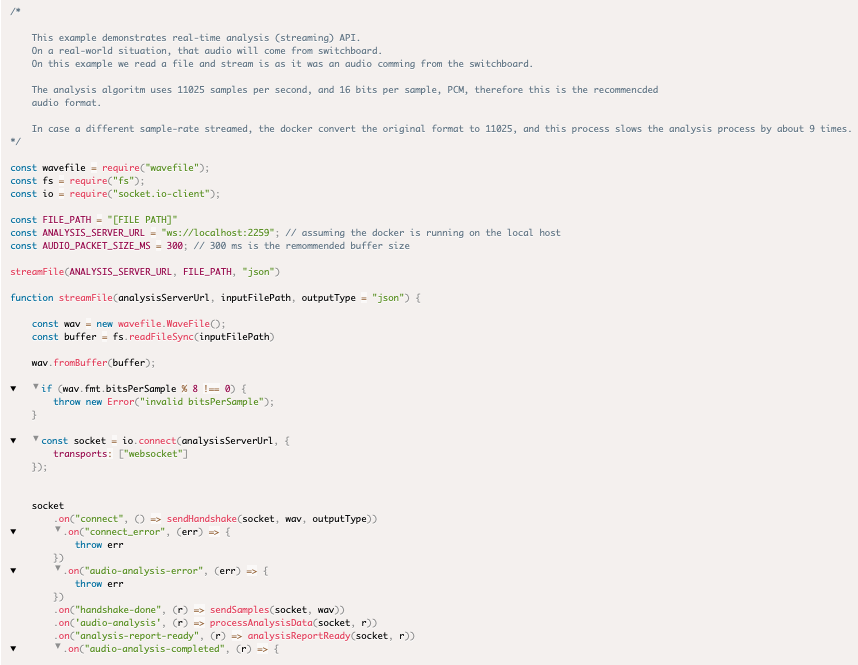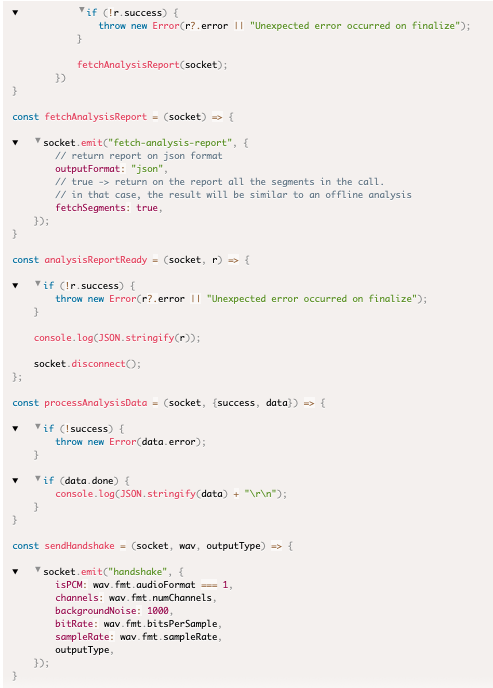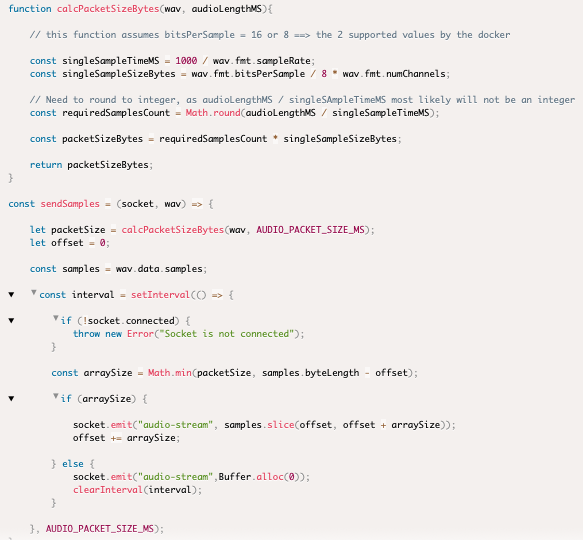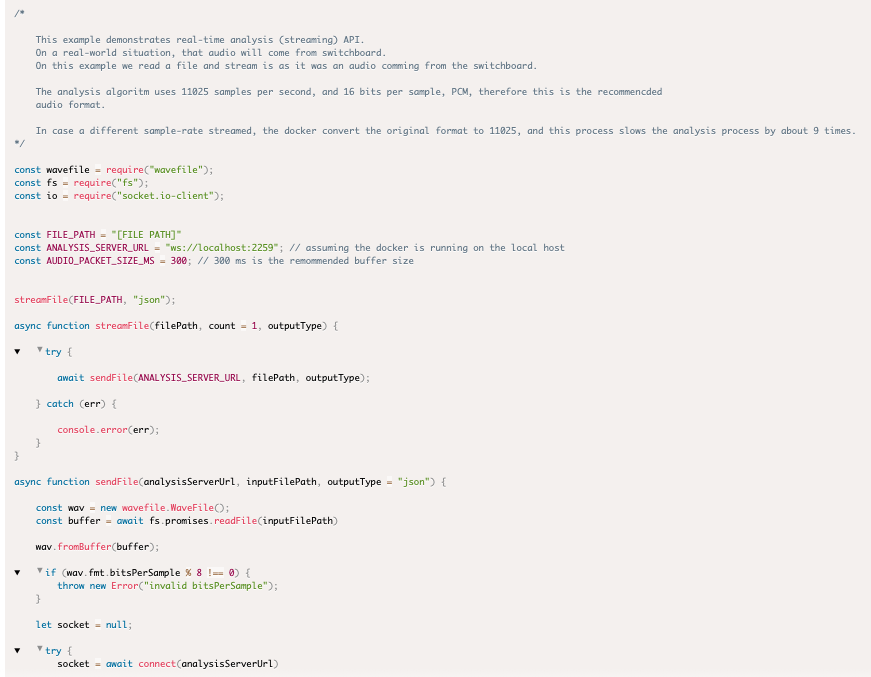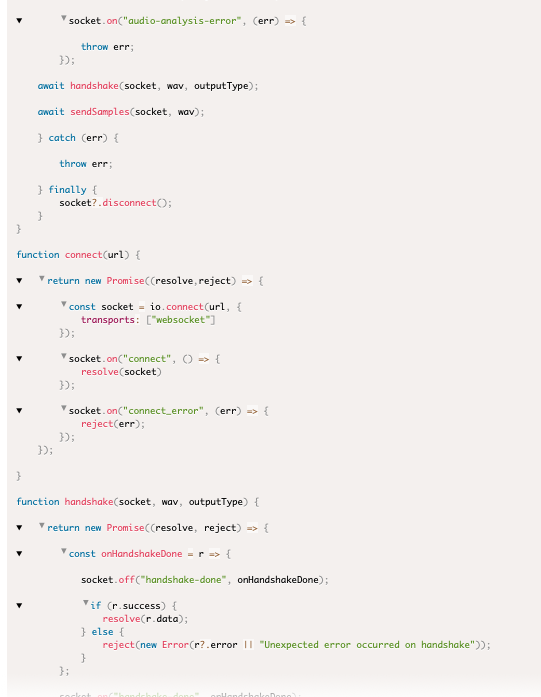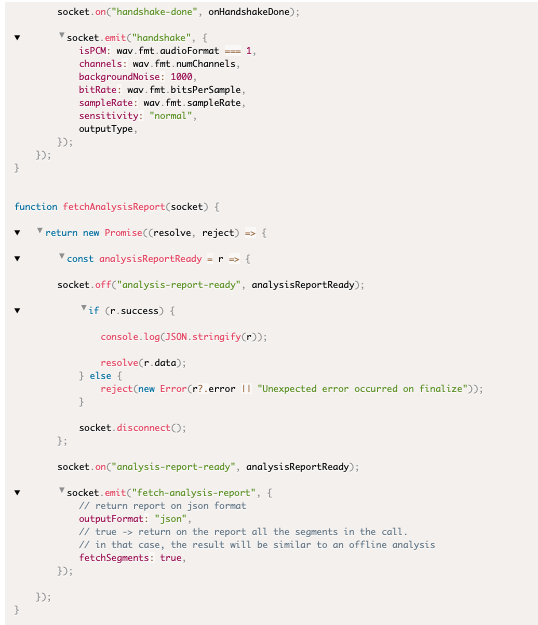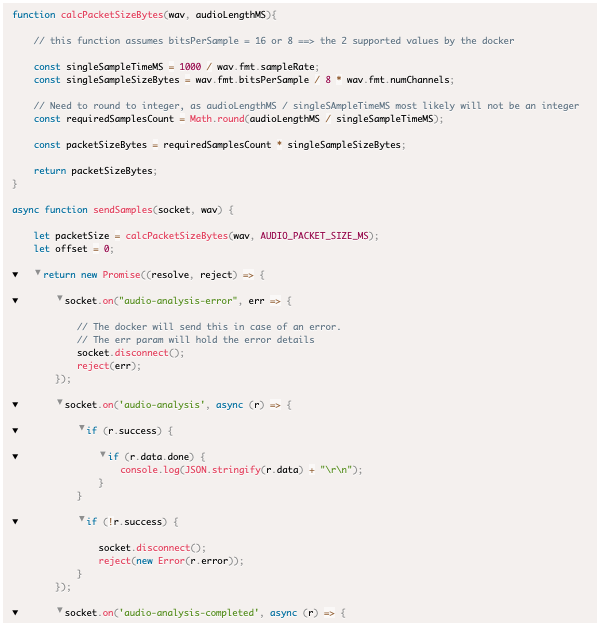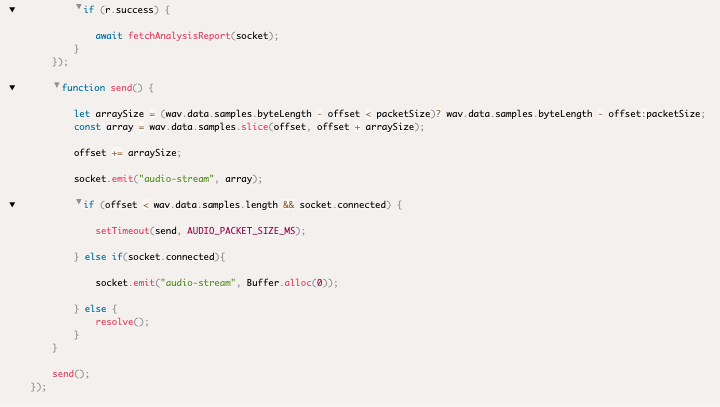Sample code - avoid promises
Sample code - Using promises
Emotion Logic docker supports integrations with 2 STT (Speech To Text) providers
- Deepgram
- Speechmatics
By setting your STT provider API Key, the Emotion Logic anlysis docker will sync its analysis to the STT results.
When activating STT on the docker, each analysis sigment will contain the spoken text at the time of the segment.
How to set STT provider API Key

1. Open the Docker dashboard and navigate to the “Integrations” tab.
2. If you do not have an account with one of the supported Speech-to-Text (STT) providers, please visit:
• Deepgram
3. Create an API Key with your chosen STT provider.
4. Enter the STT API Key in the appropriate field.
5. Save your changes.
6. Ensure that you include "useSpeechToText: true" in your analysis requests.
Release Notes: Version 7.32.1
New Features: • LOVE Values: Added all LOVE values to enhance the emotional analysis capabilities.
Improvements: • MostFanatic Function: Optimization of the MostFanatic function for better performance and accuracy.
• Passion Detection: Modified the SAF value function to improve the detection of passion.
• Strengths and Challenges: Function updated to relate to averages as a baseline, providing relative strengths and weaknesses. The function now includes “uneasy” and “arousal” metrics to keep the assessment relative.
Bug Fixes: • Channel Similarity: Fixed a bug related to similarity calculations between channels.
Updates:
• Excitement and Uncertainty: Updated the functions for Excitement and Uncertainty to align with new norms.
• BG Auto Test: Modified the BG auto test functionality. Tests are now disabled for segments shorter than 5 seconds. Users should utilize FIX BG or STT for segmentation in such cases.
Release Notes for LVA7 Tech. 7.30.1
Version Update:
Optimization: Improved CallPriority scores and call classifications tailored for call center scenarios.
Bug Fix: Resolved issues with time pointer shifts in lengthy files.
Modification: Updated FeelGPT protocol terminology to clarify message meanings (changed "Passion" to "arousal" and "passion peak" to "arousal peak").
Release Notes for LVA7 Tech. 7.29.3
We are excited to announce the release of LVA7, a significant update to our analytics platform. This version introduces several enhancements and fixes aimed at improving accuracy, usability, and comprehensiveness of risk assessments and personality insights. Here's what's new:
Enhancements:
Objective Risk Formula Optimization:
1. We've fine-tuned the Objective (OZ) risk formulas to better incorporate inaccuracy indicators, resulting in more nuanced risk assessments.
2. Users can expect a modest recalibration of risk scores, with a greater number of risk indicators and inaccuracies now being flagged.
3. For those preferring the previous version's risk evaluation, the option to revert is available by setting sensitivity: bwc1 for backward compatibility.
Introduction of Final Risk Score:
A new "Final Risk" score has been added to the risk summaries, amalgamating objective and subjective risk evaluations for a comprehensive overview.
When only one type of risk is assessed, the Final Risk score will reflect that singular assessment.
The calculation method for the Final Risk score in the Topics and Questions sections has been updated for enhanced accuracy.
Personality Assessment Enhancement: (In supported applications)
The questionnaire API now supports personality assessments at the question level.
Use isPersonality: true to designate a question for personality evaluation.
Use isPersonality: false to designate a question for risk assessment only.
Questions with a non-zero weight parameter will contribute to both personality and risk assessments. Set weight: 0 to exclude a question from risk evaluation.
Important Update Regarding isPersonality Setting:
To ensure a seamless transition and maintain backward compatibility, the isPersonality option will default to True in the current release. Be aware that this behavior is slated for a future change. We strongly recommend that users review and adjust their questionnaire settings accordingly to ensure accurate core competencies values analysis. Remember, only questions explicitly marked with isPersonality: true are factored into this analysis.
Bug Fixes:
Emotion Diamond Real-Time Values Correction:
An issue affecting the real-time values displayed on Emotion Diamond for channel 1 has been addressed, ensuring accurate emotional insight representation.
The old Nemesysco's cloud response and the new EmotionLogic response
| Nemesysco's cloud response | New Emotion-Logic response | Remarks |
|
"RISKREPT":[ |
{ |
The Topics Risk report is now more detailed and contains more items. Topic Name;Channel ID;Segment Count; Risk;Max SOS Topic Name is now "_id" "C0" - old Channel ID - this param was dropped from the new version Segment count maps to the new segmentsCount The old RISK maps to the new "riskObjective" and uses the same scale and values. "SOS" maps to the new "maxSOS" and have the same meaning and scales.
|
| "RISKREPQ":[ "Topic1;Question1;C0;1;22;75;10", "Topic1;Question2;C0;1;12;93;20", "Topic2;Question3;C0;2;84;100;30", "Topic2;Question4;C0;2;55;92;40" ], |
"reports": { "risk": { "questions": [ { "_id": "topic1", "averageJQ": 26, "averageVol1": 892, "averageVol2": 73, "maxSOS": 103, "riskObjective": 43, "riskSubjective": 85, "segmentsCount": 34 } ] } } |
The Questions Risk report is now more detailed and contains more items. Topic Name;Question Id;Channel ID;Segment Count; Risk;Max SOS Question Name is now "_id" "C0" - old Channel ID - this param was dropped from the new version Segment count maps to the new segmentsCount The old RISK maps to the new "riskObjective" and uses the same scale and values. "SOS" maps to the new "maxSOS" and have the same meaning and scales. |
| "EDPREPT":[ "Leadership;Leading by example;C0;1;25;1;38;1;20;13;83;100;100;41", "Leadership;Approach toward difficulties;C0;1;19;1;31;1;60;25;68;67;100;57", "Leadership;Leadership skills;C0;2;25;1;23;1;32;22;81;100;100;60", "Leadership;Influencing others;C0;2;38;1;24;1;34;23;81;68;98;42" ] |
Emotional Diamond data by question | |
| "SEG":[ "TotalSeg#;Seg#;TOPIC;QUESTION;Channel;StartPos;EndPos;OnlineLVA;OfflineLVA; Risk1;Risk2;RiskOZ;OZ1/OZ2/OZ3;Energy;Content;Upset;Angry;Stressed;COGLevel; EMOLevel;Concentration;Anticipation;Hesitation;EmoBalance;IThink;Imagin;SAF;OCA; EmoCogRatio;ExtremeEmotion;CogHighLowBalance;VoiceEnergy;LVARiskStress; LVAGLBStress;LVAEmoStress;LVACOGStress;LVAENRStress", "SEG1;0001;Leadership;Leading by example;C0;0.90;1.40;Calibrating... (-2);<OFFC01>;0;0; 145;4/3/1232;4;0;0;0;0;15;30;30;30;14;51;0;0;0;551;100;11;58;1356 / 66;0;0;0;0;0" ] |
Segments data by the selected application structure |
Initializing Docker with Environment Variables
In scenarios where Docker containers need to be initialized automatically—such as when deployed by Kubernetes—manual initiation through the Docker dashboard is not possible. Instead, the container can be configured to initialize itself automatically by passing the necessary environment variables.
Mandatory Environment Variables
To ensure proper authentication and functionality, the following environment variables must be provided:
• PLATFORM_APIKEY – API key for emlo.cloud
• PLATFORM_APIKEY_PASSWORD – Password for the emlo.cloud API key
To run the container with these variables, use the following command:
docker run --rm -p 8080:8080 -p 2259:2259 \
-e "PLATFORM_APIKEY=test" \
-e "PLATFORM_APIKEY_PASSWORD=test" \
--name nms-server nemesysco/on_premises
Optional Environment Variables
The following optional environment variables can be used to integrate with third-party services or modify the container’s behavior:
• DEEPGRAM_URL – Base URL for the Deepgram Speech-to-Text (STT) API
• STT_KEY – API key for Deepgram’s STT service
• SPEECHMATICS_KEY – API key for Speechmatics STT API
• WHISPER_BASE_URL – Base URL for Whisper STT API
• DISABLE_UI – A flag to disable the Docker UI. Assigning any value to this variable will disable the UI.
By configuring these variables appropriately, the container can be tailored to meet specific deployment needs.

